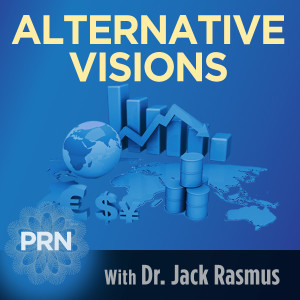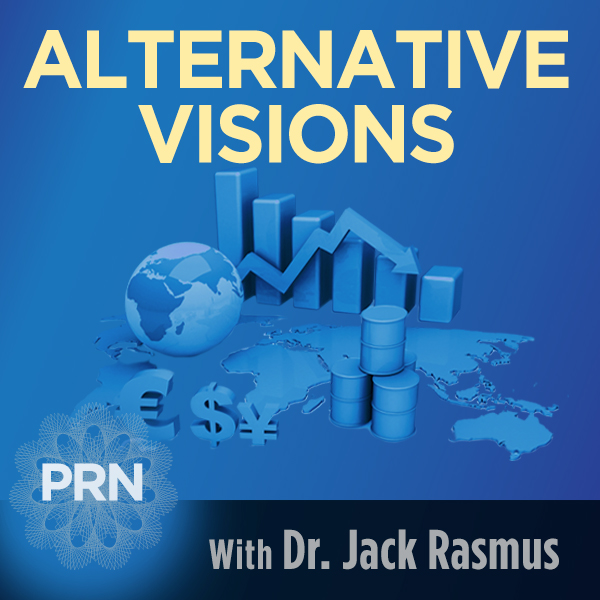Episodes

Friday Jul 27, 2018
Friday Jul 27, 2018
This week’s show addresses the past week’s ‘trade deal’ between Trump and the EU. Trump gets real EU concessions for merely suspending his threats to impose 25% auto tariffs on European parts imports to the US. Europe now will buy US soybeans and natural gas. Trump merely backs off threats in exchange. Rasmus then analyzes why US GDP for 2018 is above historical averages but will soon, in 2019, slow sharply and even retract after midyear 2019. Why rising prices are driving investment and consumer spending, not tax cuts plus how US revisions to household savings rates and corporate profits raise questions about US stats. Trump’s criticism of the Federal Reserve rate hikes. The mainstream economists debate Fed rate hikes. The show concludes with explanation how tariff wars may lead to currency devaluations and currency wars.

Friday Jul 20, 2018
Alternative Visions - Trade, Fed Rates, and Global Economy - 07.20.18
Friday Jul 20, 2018
Friday Jul 20, 2018
Dr. Rasmus reviews the status of ‘Trump Trade Wars’ re. China, Europe, and NAFTA, noting tariffs have been actually implemented on only 2.3% of total US imports and exports. Rasmus predicts: deal with NAFTA within 6 months, possibly with China in early 2019, and with the EU only after its ‘Brexit’ issue is resolved. In the meantime, much Trump threats and bombast to appeal to his domestic political base for November elections. Rasmus next addresses the Federal Reserve chair, Powell’s, testimony to Congress this past week, indicating 2 more rate hikes in 2018 and more after. Rasmus reiterates his prediction that a Fed Funds rate hike above 2.5% (now 2%) will invert the yield curve and precipitate the next recession, likely in 2019. Trump’s critique of Powell, as the Fed raises rates to finance Trump’s annual more than $1 trillion deficits and debt. Trump doesn’t want more hikes but created them with his multi-trillion dollar tax cuts and defense spending. The show concludes with discussion of signs of slowing global trade and economy, and some financial instability indicators emerging in Asian junk bonds and China markets.

Friday Jul 13, 2018
Friday Jul 13, 2018
Dr Rasmus explains the relationship between trade wars, past and present, and neoliberal tax cutting and war spending policies: Trump 2018, Reagan 1985, Nixon 1971-73. What’s next after $34 billion in US tariffs on China this past week? Relative strengths and weaknesses of US and China in the pending trade war and potential tactics. Rasmus reaffirms his prediction Trump is following a ‘two track’ trade war—one with US allies and another with China, and only China is potentially real. The role of domestic US politics in current trade disputes. A second topic of the show, i.e. accelerating global debt, is now $250 trillion and 3X global GDP, rising at$25-$32 trillion more a year. How global debt and US dollar exchange rates and central bank interest rates are related. The show concludes with review of recent data by the Institute of International Finance, confirming predictions by Rasmus that Trump January $5 trillion tax cuts for business and investors would result in lower US tax receipts, a diversion of tax savings to more stock buybacks, dividend payouts, and mergers & acquisitions—not investment, jobs, and wages. Projections of rapid slowing of US business investment and hoarding of Trump tax cuts.

Friday Jul 06, 2018
Friday Jul 06, 2018
Dr. Rasmus interviews Alan Benjamin, long time participant in Mexican and US labor politics, on the recent election of Andres Manuel Lopez-Obrador (aka AMLO) this past week. Benjamin provides an analysis of the election, and why AMLO won the election this time after having past elections he likely won in 2012 and 2006 stolen. Benjamin explains AMLO’s program evolution over 2018, the role of AMLO’s key business advisors, Urzua and Romo, selected to head, Mexico’s key cabinet positions of Secretary of Treasury and State, and AMLO’s latest views re. NAFTA and Trump. While the US media focuses on corruption and violence, various real sources of the economic and political crises in Mexico behind the election are discussed—i.e. popular demands by Mexicans for jobs, for an end to privatizations of energy and water, for restoration of Mexico’s declining healthcare services, and for repeal of past neoliberal ‘reforms’ of education and energy. Benjamin then describes the current grass roots organizing and popular committees now being formed by workers, communities, and youth to keep the AMLO election from being co-opted by US and Mexican business interests. How the AMLO election represents an important progressive ‘opening’, but also reflects a potential way of control by capitalist interests, as the old PRI and PAN business parties in Mexico have virtually collapsed. (For more information of original English translation of popular programs and events in Mexico, go to: www.socialistorganizer.com

Friday Jun 29, 2018
Friday Jun 29, 2018
Dr. Rasmus explains the yield curve as a predictor of the last 17 recessions (and the next in 2019). Why short term Fed rates are rising to finance trillion dollar annual deficits and debt and why investors and businesses aren’t convinced the Trump tax cuts will result in a growing US economy after 2018. Why the Yield Curve predicts recessions. Rasmus then discusses Wisconsin’s $4 billion tax and incentive package to lure Foxconn (the giant Taiwan corporation) to its state. Why Foxconn is not, per Trump’s quote, ‘the eighth wonder of the world’. The meaning of this week’s primary victory by Ms. Ocasio-Cortez in New York, and the Democratic Party leadership’s response. Interpreting the Kennedy Supreme Court retirement announcement. Why Trump is not a fascist, nor yet a dictator. But considers himself ‘above the law’—i.e. the definition of a Tyrant. Rasmus concludes with analysis of what the Supreme Court’s Janus decision this past week means for the intensifying attack on public employee unions now coming. (For more on Janus, listen to our March 2, 2018 Alternative Visions show and interview with SEIU union representatives).

Friday Jun 22, 2018
Friday Jun 22, 2018
Rasmus reveals plans by Trump-Congress to cut taxes still further on investors and businesses before the November elections. Also ongoing incremental tax cutting involving corporate pension fund contributions and dismantling of funding for Obamacare. The Fed’s latest bank stress tests, how they’re phony and why some US banks are still financial fragile. Rasmus also discusses the pending Teamster-UPS contract and how workers’ wage hikes will be eaten up by reductions of overtime pay and inflation. A new five year agreement will mean real pay cuts. The show concludes with latest updates on Europe, Italy’s debt, Greek debt, 3rd party critiques of the US Labor Dept.’s Alternative Work survey, and Trump’s phony trade war with Europe (and real one with China).

Friday Jun 15, 2018
Friday Jun 15, 2018
The past week’s momentous decisions by the US (Fed) and European Central Bank on interest rates is discussed. How last week’s Fed rate hike, and announcement of 4-5 more hikes to come in 2018-19, will destabilize Europe’s economy as well as Emerging Market economies. Discussion of new reports released this past week on precariate jobs in the US, US multinational corporations offshore tax havens, Corporate CEOs fivefold increase in insider stock sales as buybacks accelerate due to Trump tax cuts. Also reviewed is study released by financial fraud whistle blower, John Griffin, showing that bitcoin price bubble of 2017 was largely manipulated by Asian cryptocurrency exchange, Bitfinex. Rasmus discusses Trump listing of $50b China tariffs today and internal Italian populist government maneuvering with Euro bankers, as Euro economy (and in particular German) economies show signs of further economic slowing of exports and GDP).

Friday Jun 08, 2018
Friday Jun 08, 2018
Dr. Rasmus critiques in detail the US Labor Dept., Bureau of Labor Statistics, just released report on Contingent-Alternative Jobs, or what’s called the ‘precariate’ workforce. How the BLS under-estimates and lowballs the number and growth rate of precarious work in the US today. How narrow definitions, exclusions of groups of workers, and BLS survey methodology makes it appear the rise of precarious jobs are not a problem—contrary to many independent private studies. (For a print version, see Dr. Rasmus’s blog, jackrasmus.com, on the topic). In the second half of the show, the upcoming June 10 referendum vote in Switzerland on what is called ‘Vollgeld’ is addressed. The proposal for what is called ‘sovereign money’ creation, represented by the referendum, is explained in the broader context of the increasing failure of central banks in the advanced economies to stabilize the capitalist economy. How the central bank solution to the 2008-09 crash—via QE and zero rates for 8 years—will be insufficient in the next crisis. Hence, the new experiments like Vollgeld on how to bail out the economy are being explored. Vollgeld-sovereign money as a new way to permanently bail out the private banks by having central banks assume all their debt perpetually.

Friday Jun 01, 2018
Friday Jun 01, 2018
Dr. Rasmus on Trump’s lifting exemptions on US tariffs on NAFTA-Europe steel & aluminum. The oft-ignored role of US domestic politics in Trump trade actions. Trump negotiating strategy and tactics. Why there’ll be no trade war with Mexico-Canada or Europe, but may yet be with China. NAFTA and Europe partners’ tepid responses to Trump announcement (Mexico $4b, Canada $16b, Europe $7.5b counter-tariffs compared to US $2.4 trillion total annual exports). Three-way splits in US-China trade negotiating team. The US ‘dual track’ trade negotiations strategy. In the second half hour, Rasmus addresses the emerging Italian Debt crisis and its similarities to the 2012-15 Greek debt crisis. Italy’s insolvent private banking system, $500b in nonperforming bank loans, and government debt of 130% of GDP. Contagion potential to French banks. 5-Star populist party-Greek Syriza party compared. Italy as Greek debt crisis writ large. How financial imperialism works in the Eurozone.

Friday May 25, 2018
Friday May 25, 2018
Dr. Rasmus provides the latest, 1st quarter 2018, updates on accelerating S&P 500 US corporate stock buybacks, dividend payouts, and spending on corporate mergers and acquisitions. Latest data show $178b in buybacks and $113b in dividends and $840b in M&A spending estimates for 2018—i.e. a combined $2.01 trillion for just the S&P 500 largest corporations for the coming year alone. 2nd quarter estimates of buybacks for all US corporations now running at $6.1b per day and thus even higher. How the Trump-Congress $5 trillion tax cuts are the impetus for the more than $2 trillion boost in capital incomes for 2018-19. The Congressional Budget Office (CBO) estimate this week the Trump budget deficit will be $9.5 trillion, and $2.3 trillion greater than Trump-Ryan claim. (Dr. Rasmus estimate: $12.4 trillion and higher if recession occurs within next decade). Consequences for the US and global economy of the massive deficit-debt are discussed. The show concludes with explanation of last week’s US Supreme Court’s ‘Epic Systems Corp. vs. Lewis’ decision, denying workers the right to engage in mutual, collective action to defend their working conditions and forcing them to individually arbitrate their disputes with their company. A threshold SCOTUS decision that will overturn the 1935 Wagner Act giving workers the right to unionize for the first time in the US. SCOTUS decision the latest in intense legal attack on workers rights now underway, driven by Koch brothers and other anti-worker, anti-union groups. Rasmus briefly reviews the history of how courts and laws were used to prevent worker-union rights. US now returning to pre-1935 period in US labor history with Epic Systems decision.

